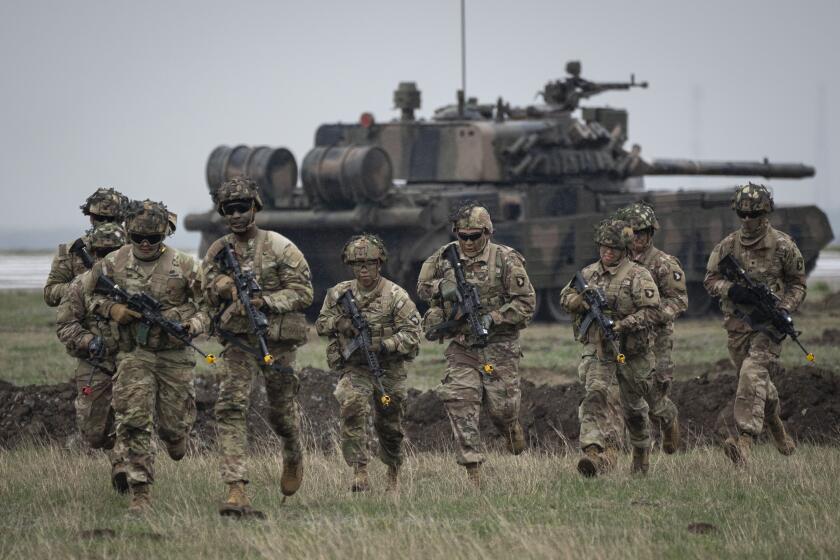Why the U.S. is willing to supply Ukraine with controversial cluster munitions

- Share via
WASHINGTON — The U.S. has decided to send cluster munitions to Ukraine to help its military push back Russian forces entrenched along the front lines.
The Biden administration will provide thousands of the cluster munitions to Ukraine, national security adviser Jake Sullivan said Friday, vowing the U.S. will not leave Ukraine defenseless and that Kyiv has promised to use the controversial munitions carefully.
The munitions shipment is part of a new military aid package worth $800 million, according to people familiar with the decision who spoke on condition of anonymity because they were not authorized to discuss it publicly before the official announcement.
The decision comes on the eve of the NATO summit in Lithuania, where President Biden is likely to face questions from allies on why the U.S. would send a weapon into Ukraine that more than two-thirds of alliance members have banned because it has a track record for causing many civilian casualties.
The move will likely trigger outrage from some allies and humanitarian groups that have long opposed the use of cluster bombs.
Proponents argue that Russia has already been using the controversial weapon in Ukraine and that the munitions the U.S. will provide have a reduced dud rate, meaning that there will be far fewer unexploded rounds that can result in unintended civilian deaths.
Here is a look at what cluster munitions are, where they have been used and why the U.S. plans to provide them to Ukraine now.
What is a cluster munition?
A cluster munition is a bomb that opens in the air and releases smaller “bomblets” across a wide area. The bomblets are designed to take out tanks and equipment, as well as troops, hitting multiple targets at the same time.
The munitions are launched by the same artillery weapons that the U.S. and allies have already provided to Ukraine for the war — such as howitzers — and the type of cluster munition that the U.S. is planning to send is based on a common 155-millimeter shell that is already widely in use across the battlefield.
The Biden administration has provided more than $37.6 billion in security assistance to Ukraine since Russia invaded in February 2022.
In previous conflicts, cluster munitions have had a high dud rate, which meant that thousands of the smaller unexploded bomblets remained behind and killed and maimed people decades later. The U.S. last used its cluster munitions in battle in Iraq in 2003 and decided not to continue using them as the conflict shifted to more urban environments with denser civilian populations.
On Thursday, Brig. Gen. Pat Ryder said the Defense Department has “multiple variants” of the munitions and “the ones that we are considering providing would not include older variants with [dud] rates that are higher than 2.35%.”
Why provide them now?
For more than a year, the U.S. has dipped into its own stocks of traditional 155-millimeter howitzer munitions and sent more than 2 million rounds to Ukraine. Allies across the globe have provided hundreds of thousands more.
A 155-millimeter round can strike targets 15 to 20 miles away, making them a munition of choice for Ukrainian ground troops trying to hit enemy targets from a distance. Ukrainian forces are burning through thousands of the rounds a day battling the Russians.
Yehor Cherniev, a member of Ukraine’s parliament, told reporters recently at a German Marshall Fund event in the U.S. that Kyiv would likely need to fire 7,000 to 9,000 of the rounds daily in intensified counteroffensive fighting. Providing that many puts substantial pressure on U.S. and allied stocks.
The fact that Wagner chief Yevgeny Prigozhin remains unpunished despite his forces’ armed revolt shows the weakening state of Russia’s legal system.
The cluster bomb is an attractive option because it would help Ukraine destroy more targets with fewer rounds, and since the U.S. hasn’t used them in conflict since Iraq, it has large amounts of them in storage it can access quickly, said Ryan Brobst, a research analyst for the Foundation for Defense of Democracies.
A March letter from top House and Senate Republicans to the Biden administration said the U.S. may have as many as 3 million cluster munitions available for use, and urged the White House to send the munitions to alleviate pressure on U.S. war supplies.
“Cluster munitions are more effective than unitary artillery shells because they inflict damage over a wider area,” Brobst said. “This is important for Ukraine as they try to clear heavily fortified Russian positions.”
Tapping into the U.S. stores of cluster munitions could address Ukraine’s shell shortage and alleviate pressure on the 155-millimeter stockpiles in the U.S. and elsewhere, Brobst said.
Is using them a war crime?
Use of cluster bombs itself does not violate international law, but using them against civilians can be a violation. As in any strike, determining a war crime requires looking at whether the target was legitimate and whether precautions were taken to avoid civilian casualties.
“The part of international law where this starts playing [a role], though, is indiscriminate attacks targeting civilians,” Human Rights Watch’s associate arms director Mark Hiznay told the Associated Press. “So that’s not necessarily related to the weapons, but the way the weapons are used.”
How do citizens of Kyiv cope with the sleep deprivation and stress from Russia’s war on Ukraine? Some push it down, some try yoga or dancing.
A convention banning the use of cluster bombs has been joined by more than 120 countries, which agreed not to use, produce, transfer or stockpile the weapons and to clear them after they’ve been used. The U.S., Russia and Ukraine haven’t signed on.
Where have they been used?
The bombs have been deployed in many recent conflicts, including by U.S. forces.
The U.S. initially considered cluster bombs an integral part of its arsenal during the invasion of Afghanistan that began in 2001, according to Human Rights Watch. The group estimated that the U.S.-led coalition dropped more than 1,500 cluster bombs in Afghanistan during the first three years of the conflict.
The Defense Department had been due by 2019 to stop use of any cluster munitions with a rate of unexploded ordnance greater than 1%. But the Trump administration rolled back that policy, allowing commanders to approve use of such munitions.
Syrian government troops often used cluster munitions — supplied by Russia — against opposition strongholds during that country’s civil war, frequently hitting civilian targets and infrastructure. And Israel used them in civilian areas in south Lebanon, including during the 1982 invasion.
In the 1980s, the Russians made heavy use of cluster bombs during their 10-year invasion of Afghanistan. As a result of decades of war, the Afghan countryside remains one of the most heavily mined countries in the world.
What’s happening in Ukraine?
Russian forces have used cluster bombs in Ukraine on a number of occasions, according to Ukrainian government leaders, observers and humanitarian groups. And human rights groups have said Ukraine has also used them.
A top NATO military officer says Russia’s armed forces are bruised but by no means beaten in the war in Ukraine and should not be underestimated.
During the early days of the war, there were repeated instances of Russian cluster bombs cited by groups such as Human Rights Watch, including when they hit near a preschool in the northeastern city of Okhtyrka. The open-source intelligence group Bellingcat said its researchers found cluster munitions in that strike as well as multiple cluster attacks in Kharkiv, Ukraine’s second-largest city, also in the northeast.
More recently, in March, a Russian missile and drone barrage hit a number of urban areas, including a sustained bombardment in Bakhmut, in the eastern Donetsk region. Just west of there, shelling and missile strikes hit the Ukrainian-held city of Kostiantynivka, and AP journalists in the city saw at least four injured people taken to a hospital. Police said Russian forces attacked the town with S-300 missiles and cluster munitions.
Just a month later, Donetsk Gov. Pavlo Kyrylenko accused Russian forces of attacking a town with cluster munitions, wounding one person. An AP and Frontline database called War Crimes Watch Ukraine has cataloged how Russia has used cluster bombs.
More to Read
Sign up for Essential California
The most important California stories and recommendations in your inbox every morning.
You may occasionally receive promotional content from the Los Angeles Times.

















